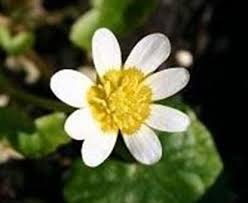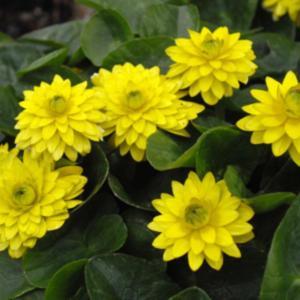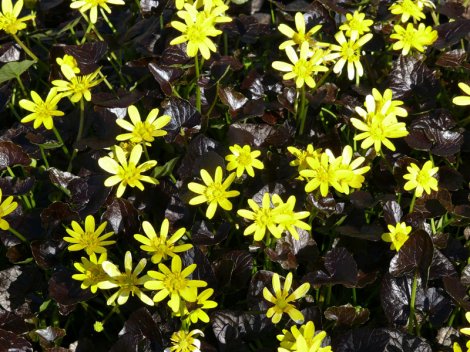Spotlight on: Celandine

Celandine are one of the delights of early spring and among the first plants to flower in the countryside. They are delightful little flowers and true harbingers of spring.
Perfect for under trees, shrubs or alongside hedges, they can also be used in containers. Celandines do their thing early in the year and are dormant in summer, so are perfect for under-planting deciduous plants to make them more interesting before their leaves come out later. Alternatively they can be planted with something that comes up later, such as hostas or hardy geraniums etc.
The native common celandine is a bit of a thug and once you've got it, it's there for life, but several hybrids have found or bred and these are much more restrained and better behaved. Celandines are easy to grow and happy in any soil that isn't permanently waterlogged. They have good drought resistance when established as they die back to dormant tubers over the summer.

Myth, legend and history:
Lesser celandine has been used in cooking throughout history. The plant's roots swell up to form bulbs or tubers, which are reputedly delicious and can be eaten as a starchy vegetable. Lesser celandine has been used as potherb in central Europe and the young parts of the plant have been added to salads.
Celandine flowers given as a gift implies Joys to Come or reawakening. Wearing a fresh celandine flower against the skin is alleged to enable the wearer to avoid any traps set for them and escape unwanted imprisonment. This may be due to another power attributed to it, that of ensuring the wearer wins the favour of judge and jury when appearing in court.
The plant is known as pilewort by some herbalists because it has historically been used to treat piles (haemorrhoids). Lesser celandine is still recommended in several "current" herbal guides for treatment of haemorrhoids by applying an ointment of raw leaves as a cream or lanolin to the affected area. Supposedly, the knobby tubers of the plant resemble piles, and according to the doctrine of signatures this resemblance suggests that pilewort could be used to cure piles.
Edward Thomas wrote a poem entitled "Celandine". Encountering the flower in a field, the narrator is reminded of a past love, now dead.
Wordsworth was keen on the flower too and wrote a poem entitled 'The Lesser Celandine'. Upon his death it was proposed that a celandine be carved on his memorial plaque inside St Oswald's Church, Grasmere, but unfortunately the greater celandine Chelidonium majus was mistakenly used.
N.B. until relatively recently, celandines were categorised as Ranunculus rather than Ficaria.

We offer three varieties for sale:
Ficaria verna 'Fried Egg' - as the name suggests, each flower resembles a fried egg. As with all celandine, it looks stunning when forming a large clump.
Ficaria verna 'Flore Pleno' - masses of double flowers of lemony-yellow with lime-green centres.
Ficaria verna 'Brazen Hussy' - yellow flowers contrast beautifully with dark brown polished leaves. Stunning.
To view details or buy, follow this link:

